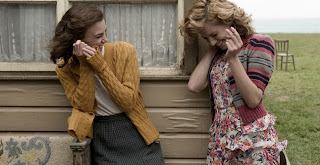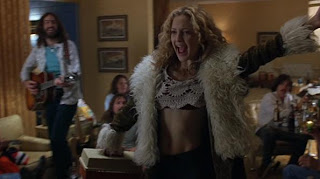Anthony
Minghella’s 1999 remake of Patricia Highsmith’s novel, The Talented Mr. Ripley has long been overlooked and underrated.
Who knows, perhaps this only further adds to the film’s mystique, akin to the
best restaurant in town where only the locals are privy to its secret. The
title’s namesake, Tom Ripley (Matt Damon) is but a bathroom attendant who’s
borrowed a fancy jacket to play the piano at a high class New York event. Following
a case of mistaken identity, an inhabitant of this rich world - Herbert
Greenleaf - takes Tom for an old Princeton chum of his son, Dickie (Jude Law).
He offers Tom money to help convince his estranged son Dickie to return home
from the idyllically meaningless lifestyle he lives in Italy with girlfriend
Marge (Gwyneth Paltrow). Unknowingly, he is offering Tom the golden ticket into
a world of decadence and luxury set against a lavishly beautiful backdrop of
southern Italy. What ensues is a warped and unfurling plot of little white
lies, larger dark lies and twisted truths - all told in order to stay in the
game. In this world of double lives and overlapping identities, costume plays a
defining role.
Transporting us instantly to the bliss and exuberance of sun-dappled Italy, the palette of the film itself is awash in a sea of bleached out tones. A menagerie of pastels and creams across the spectrum, the scenes appear almost faded by the heat of the sun, as if the film dailies have quite literally been left outside. The effect is carefree and light; an effect that transfers over to the lives and costumes of the main characters: a beautiful mix of American prep and southern Italian style. Dickie is the epitome of this American wealth and status and this is reflected in both his choice of style and in his clothing itself. He clads himself in a wide selection of blazers, jackets and linen trousers and portrays an air of casual liberation. Despite this, his wealth shines through; his well-fitting and high quality clothes an indication of his affluence. He accessorises plentifully and generously, adorning himself in expensive jewellery, hats and opulent ties.
As much as Dickie's clothes are driven by taste, Tom Ripley's choices are driven purely by need. Tom is very much dressed in a sartorial portrayal of the boy next door, complete with gingham, corduroy and a palette of plain, block colours. His too is an all-American look, this time however, owing to the fact that he has never travelled and has not experienced culture other than his own. His one dimensional look and lifestyle means that he does not own many clothes and is often seen in the same brown jacket, much to the ridicule of an amused Dickie. Unlike Dickie, he does not accessorise to excess, sticking to his horn-rimmed glasses and wrist watch out of a compliant necessity.
As Tom begins to imitate Dickie's lavish lifestyle, he too begins to have his suits custom made in Italy. He further mimics Dickie's look and behaviour, imitating his language, mannerisms and even his voice. He combs his hair back and wears Dickie's belongings such as his gold ring that Marge has previously given to him. Here the costume is playing a role as much as the characters themselves in the ever twisting plot. It is indeed when Marge spots Tom with Dickie's ring - the ring he promised that he would never give to anyone - that she becomes suspicious of Tom's existence in her world.
Demonstrating an idiosyncratic blend of Debutante-does-Riviera style, Marge is from an affluent family and is not dictated by money. An all-American young intellectual, she is in Italy to work on her book, albeit at a leisurely pace whilst enjoying the high life with Dickie. Her clothes are no doubt designer label and high-end luxury; however this is due to an inherent practicality of her social and financial milieu and not born out of a need to show off with the latest designer 'name'. For the first half of the film, she is clad in dainty, easy colours, simple linens and light shapes. She is a great fan of the classically white shirt, tied elegantly at the waist and teamed with a floral midi skirt. Her look is girlish and flirty with more than a hint of Grace Kelly. She is the carefree epitome of resortwear and '50s high waists, unable to resist finishing them with the preppy oxford lace-ups of her past.
Later, as her life begins to unravel at the seams, she begins to channel a much darker look - akin almost to the Hitchcock blondes of times past. She dons a heavy leopard print coat and a decidedly more ominous demeanour, complete with the ultimate accessory of mystique: a cigarette. Her life is no longer sweetness and light and she is grittily determined to find out why.
In a film as twisted and mysteriously thrilling as The Talented Mr. Ripley, costume plays an undeniable role. Each character endures a transition of their own, their agenda shrouded in the mystery of an evolving plot and their clothing choices acting almost as a subconscious display of their inner turmoil.
Transporting us instantly to the bliss and exuberance of sun-dappled Italy, the palette of the film itself is awash in a sea of bleached out tones. A menagerie of pastels and creams across the spectrum, the scenes appear almost faded by the heat of the sun, as if the film dailies have quite literally been left outside. The effect is carefree and light; an effect that transfers over to the lives and costumes of the main characters: a beautiful mix of American prep and southern Italian style. Dickie is the epitome of this American wealth and status and this is reflected in both his choice of style and in his clothing itself. He clads himself in a wide selection of blazers, jackets and linen trousers and portrays an air of casual liberation. Despite this, his wealth shines through; his well-fitting and high quality clothes an indication of his affluence. He accessorises plentifully and generously, adorning himself in expensive jewellery, hats and opulent ties.
As much as Dickie's clothes are driven by taste, Tom Ripley's choices are driven purely by need. Tom is very much dressed in a sartorial portrayal of the boy next door, complete with gingham, corduroy and a palette of plain, block colours. His too is an all-American look, this time however, owing to the fact that he has never travelled and has not experienced culture other than his own. His one dimensional look and lifestyle means that he does not own many clothes and is often seen in the same brown jacket, much to the ridicule of an amused Dickie. Unlike Dickie, he does not accessorise to excess, sticking to his horn-rimmed glasses and wrist watch out of a compliant necessity.
As Tom begins to imitate Dickie's lavish lifestyle, he too begins to have his suits custom made in Italy. He further mimics Dickie's look and behaviour, imitating his language, mannerisms and even his voice. He combs his hair back and wears Dickie's belongings such as his gold ring that Marge has previously given to him. Here the costume is playing a role as much as the characters themselves in the ever twisting plot. It is indeed when Marge spots Tom with Dickie's ring - the ring he promised that he would never give to anyone - that she becomes suspicious of Tom's existence in her world.
Demonstrating an idiosyncratic blend of Debutante-does-Riviera style, Marge is from an affluent family and is not dictated by money. An all-American young intellectual, she is in Italy to work on her book, albeit at a leisurely pace whilst enjoying the high life with Dickie. Her clothes are no doubt designer label and high-end luxury; however this is due to an inherent practicality of her social and financial milieu and not born out of a need to show off with the latest designer 'name'. For the first half of the film, she is clad in dainty, easy colours, simple linens and light shapes. She is a great fan of the classically white shirt, tied elegantly at the waist and teamed with a floral midi skirt. Her look is girlish and flirty with more than a hint of Grace Kelly. She is the carefree epitome of resortwear and '50s high waists, unable to resist finishing them with the preppy oxford lace-ups of her past.
Later, as her life begins to unravel at the seams, she begins to channel a much darker look - akin almost to the Hitchcock blondes of times past. She dons a heavy leopard print coat and a decidedly more ominous demeanour, complete with the ultimate accessory of mystique: a cigarette. Her life is no longer sweetness and light and she is grittily determined to find out why.
In a film as twisted and mysteriously thrilling as The Talented Mr. Ripley, costume plays an undeniable role. Each character endures a transition of their own, their agenda shrouded in the mystery of an evolving plot and their clothing choices acting almost as a subconscious display of their inner turmoil.











































